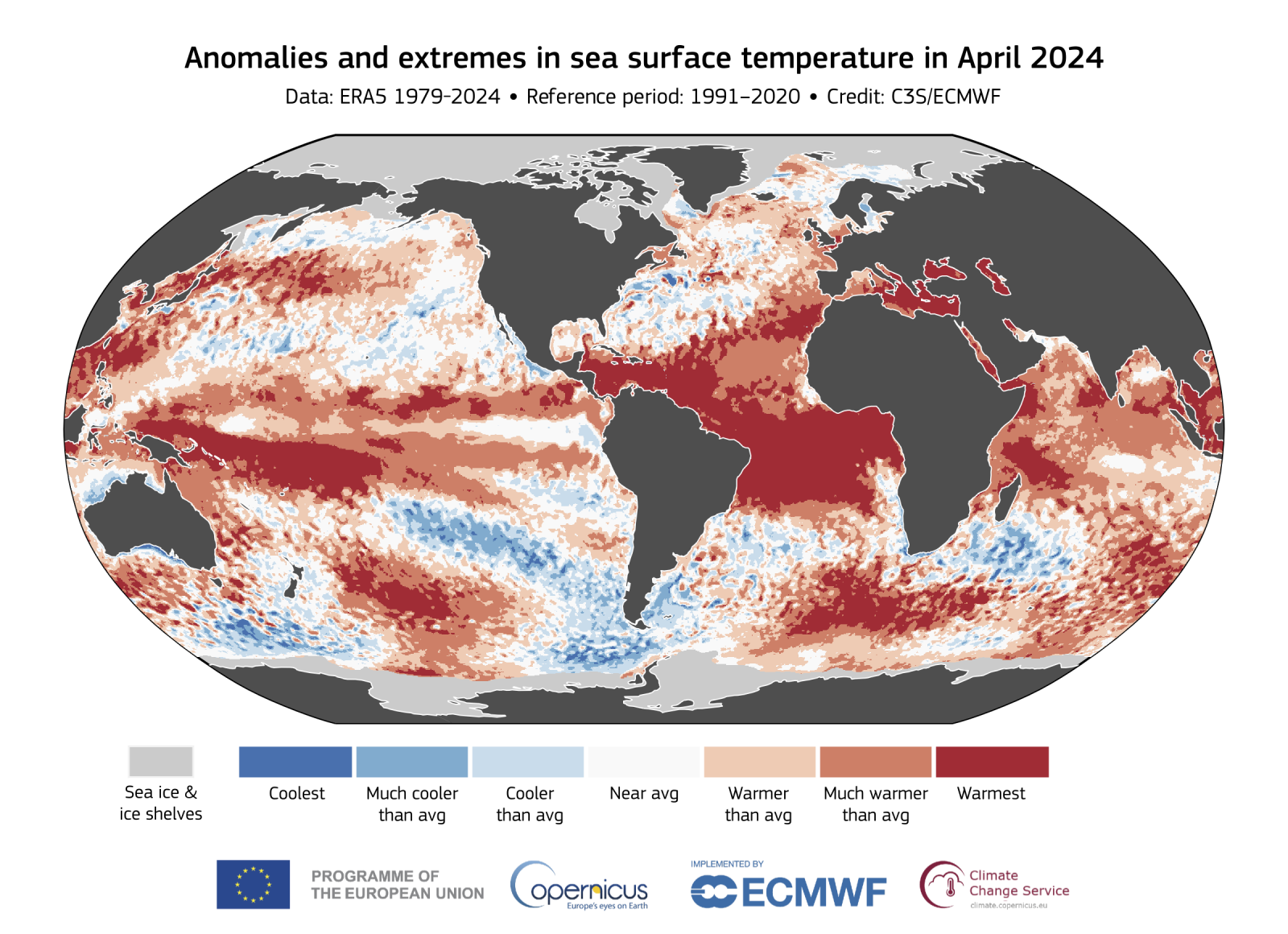
The global surface air temperature for April was 15.03°C, 0.67°C above the 1991-2020 average for April and 0.14°C above the previous high set in April 2016. It is the 11th month in a row setting record temperatures for the respective month in the Copernicus Climate Change Service (C3S) ERA5 reanalysis dataset. While such a long series of records is unusual, a similar series of record temperatures was observed in 2015/2016, lasting up to 15 months.
Globally, the last 12 months (May 2023-April 2024) were warmer than any previous 12-month period, at 0.73°C above the 1991-2020 average and 1.61°C above the pre-industrial average.
Despite the weakening of El Niño towards neutral conditions in the eastern equatorial Pacific, the global average sea surface temperature (SST) outside the polar regions was once again the warmest for the respective month of the year, continuing a series of 13 monthly records in a row.
Anomalies and extremes in sea surface temperature percentiles in April 2024. Colour categories refer to the percentiles of the temperature distributions for the 1991–2020 reference period. The extreme ("Coolest" and "Warmest") categories refer to the period 1979–2024. Values are only calculated for the ice-free oceans. Areas covered with sea ice and ice shelves in April 2024 are shown in light grey. Data source: ERA5. Credit: Copernicus Climate Change Service/ECMWF.
C3S data shows that even though the recent El Niño event has played an important role in the recent record global SST observed during the past months, other regions of the global ocean have also been much warmer than average with areas of the Atlantic, the Indian Ocean, the Southern Ocean and the extra-tropical Pacific ocean seeing record high SSTs values for April.
"El Niño peaked at the beginning of the year, and the sea surface temperatures in the eastern tropical pacific are now going back towards neutral conditions. However, whilst temperature variations associated with natural cycles like El Niño come and go, the extra energy trapped into the ocean and the atmosphere by increasing concentrations of greenhouse gases will keep pushing the global temperature towards new records." Said Carlo Buontempo, Director of the Copernicus Climate Change Service in a press release.
For Europe it was the second warmest April on record after April 2018. Temperatures were most above average in eastern Europe. Conversely, Fennoscandia and Iceland experienced well-below average temperatures. In western Europe, the mean temperature masks the contrast between warmer and colder temperatures experienced during the month.
See the application Climate Pulse for near-real time and historical series of global surface air and sea surface temperatures.
Read the April 2024 Surface air temperature update in full.
April 2024 was mainly wetter over most of north-western, central and north-eastern Europe. Large areas of Spain, Italy, the western Balkans, Türkiye, Russia, Ukraine and Iceland were drier than average.
Soil moisture remained higher than average in the western Iberian Peninsula despite lower-than-average precipitation, a legacy of March rainfall.
Snowmelt and precipitation led to the Ural and Ishin rivers bursting their banks leading to severe inundations in Russia and Kazakhstan.
The Persian Gulf saw short-lived exceptional and occasionally record precipitation events with the United Arab Emirates and Oman experiencing flash floods and widespread damage.
Read the April 2024 Hydrological variables update in full.
The Arctic sea ice extent anomaly was relatively small (2% below average) compared to the April anomalies observed in the last decade. Sea ice concentrations remained above average in the Greenland Sea, following a persistent pattern since October. Sea ice concentrations were below average in the northern Barents Sea and in the northern Bering Sea. Antarctic sea ice extent was the 10th lowest for April at 9% below the average for April. The region has been experiencing a pattern of large negative anomalies since 2017, with exceptions in 2020 and 2021.
Source : https://climate.copernicus.eu/april-2024-11th-consecutive-warmest-month-globally